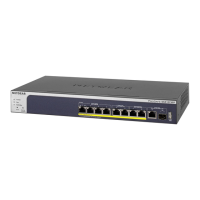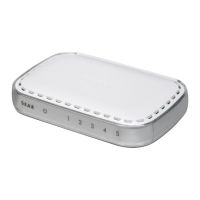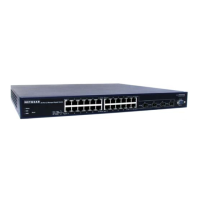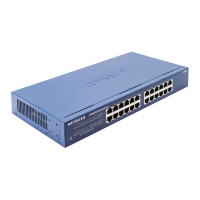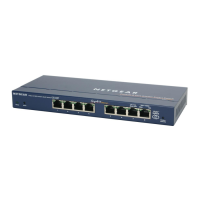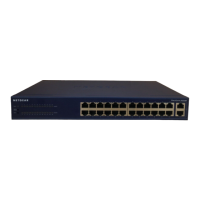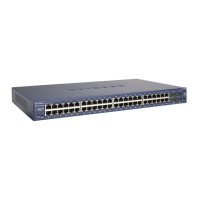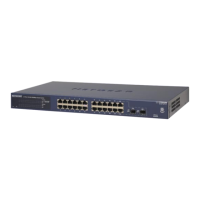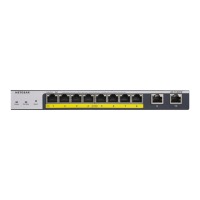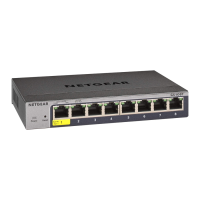Do you have a question about the NETGEAR Nighthawk SX10 Pro Gaming and is the answer not in the manual?
Lists available documentation such as installation guides and data sheets.
Details the items included in the switch package.
Explains the status indicators on the switch's top and back panels.
Describes the components and ports located on the switch's back panel.
Details the information found on the switch's bottom panel label.
Provides essential safety guidelines for using the switch.
Guides on connecting the switch to your network and powering it on.
Outlines ways to find and access the switch's management interface.
Steps to access the switch via IP address using a Windows-based computer.
Instructions for assigning a static IP address to the switch.
How to use the NETGEAR Insight app to discover and manage the switch.
Procedure to change the display language of the switch's interface.
Guide on how to change the default login password for security.
Instructions for registering the switch for support and alerts.
Overview of predefined modes to optimize switch performance.
Configures the switch for optimal gaming performance by minimizing latency.
Optimizes the switch for high-throughput media streaming applications.
Sets the switch to default performance with equal priority for all ports.
Tools to monitor traffic and adjust gaming settings like port priority.
Allows saving and managing custom switch configurations.
Procedure to save current QoS and other settings as a custom preset.
How to apply previously saved custom switch configurations.
Allows renaming saved custom preset modes.
Procedure for removing custom preset modes.
Manual configuration of QoS modes and port rate limits.
Configures port priorities and rate limits using port-based QoS.
Utilizes 802.1P or DSCP information for packet prioritization.
Controls broadcast storms and sets storm control rate limits per port.
Configures individual port settings like speed, flow control, and naming.
Limits incoming and outgoing traffic rates for specific ports.
Assigns priority levels (P0-P7) to individual ports.
Enables or disables IEEE 802.3x flow control on a per-port basis.
Allows manual setting of port speed or disabling a port.
Restores functionality to a blocked or disabled network port.
Assigns or modifies descriptive name labels for switch ports.
Explains Virtual LANs (VLANs) and their grouping criteria.
Enables basic port-based VLANs and assigns ports to VLANs.
Covers creating, changing, and deleting advanced port-based VLANs.
Enables the advanced port-based VLAN mode for more complex configurations.
Instructions for creating new advanced port-based VLANs.
Modifies settings for existing advanced port-based VLANs.
Removes advanced port-based VLANs that are no longer needed.
Covers creating, changing, and deleting basic 802.1Q VLANs.
Enables the basic 802.1Q VLAN mode for standard VLAN configurations.
Guides on creating basic 802.1Q VLANs and assigning ports.
Sets port modes (Access or Trunk) within basic 802.1Q VLANs.
Modifies settings for existing basic 802.1Q VLANs.
Removes basic 802.1Q VLANs that are no longer required.
Covers creating, changing, and deleting advanced 802.1Q VLANs.
Enables the advanced 802.1Q VLAN mode for flexible configurations.
Instructions for creating new advanced 802.1Q VLANs.
Modifies settings for existing advanced 802.1Q VLANs.
Assigns a default port VLAN ID (PVID) for incoming packets.
Configures a VLAN as voice VLAN and adjusts its Class of Service (CoS).
Manages Organizationally Unique Identifiers (OUIs) for voice VLANs.
Removes advanced 802.1Q VLANs that are no longer needed.
Disables VLAN modes and removes all configured VLANs.
Configures protocols like UPnP, Bonjour, and NSDP for switch discovery.
Enables or disables UPnP for network discovery and access.
Manages Bonjour service for discovery on Mac OS devices.
Manages NSDP for discovery by NETGEAR devices and applications.
Covers multicast traffic handling and IGMP snooping configuration.
Enables or disables IGMP snooping for efficient multicast traffic forwarding.
Configures IGMP snooping specifically for a VLAN.
Blocks multicast traffic from unknown addresses to reduce network load.
Enables IGMPv3 IP header validation for packet conformity.
Designates a static port for IGMP snooping queries.
Combines multiple ports into a single logical link for bandwidth or redundancy.
Guides on creating and configuring link aggregation groups (LAGs).
Details on physically connecting devices for link aggregation.
Activates configured link aggregation groups on the switch.
Instructions to disable DHCP client and set a static IP address.
Restores the switch to obtaining an IP address via DHCP.
Process for checking, downloading, and installing switch firmware updates.
Covers backing up and restoring switch configuration files.
Saves the current switch settings to a file on your computer.
Applies a previously saved configuration file to the switch.
Resets the switch to its original factory default settings.
Procedure to reset the switch to factory defaults using the physical button.
How to reset the switch to factory defaults via the web interface.
Specifies IP addresses allowed to access the switch's management interface.
Modifies or removes IP-based access restrictions for switch management.
Configures power saving features like IEEE 802.3az.
Customizes the activity and color of port and power LEDs.
Adjusts activity, frequency, color, and brightness for single port LEDs.
Applies LED settings to multiple ports simultaneously.
Restores port LEDs to their default behavior and appearance.
Configures the activity and color of the switch's power LED.
Displays switch details like firmware version, MAC, and serial number.
Renames the switch for easier identification on the network.
Shows the number of established network connections on the switch.
Provides detailed status information for individual network ports.
Diagnoses network cable health and detects fault distances.
Enables or disables loop detection and blocking.
Mirrors traffic from source ports to a destination port for analysis.
Displays detailed traffic statistics for each port.
Remotely restarts the switch using its web interface.
Steps to resolve IP subnet conflicts for network access.
Lists common hardware symptoms, causes, and solutions.
Details the default configuration settings of the switch.
Provides key hardware specifications like network interfaces and standards.
